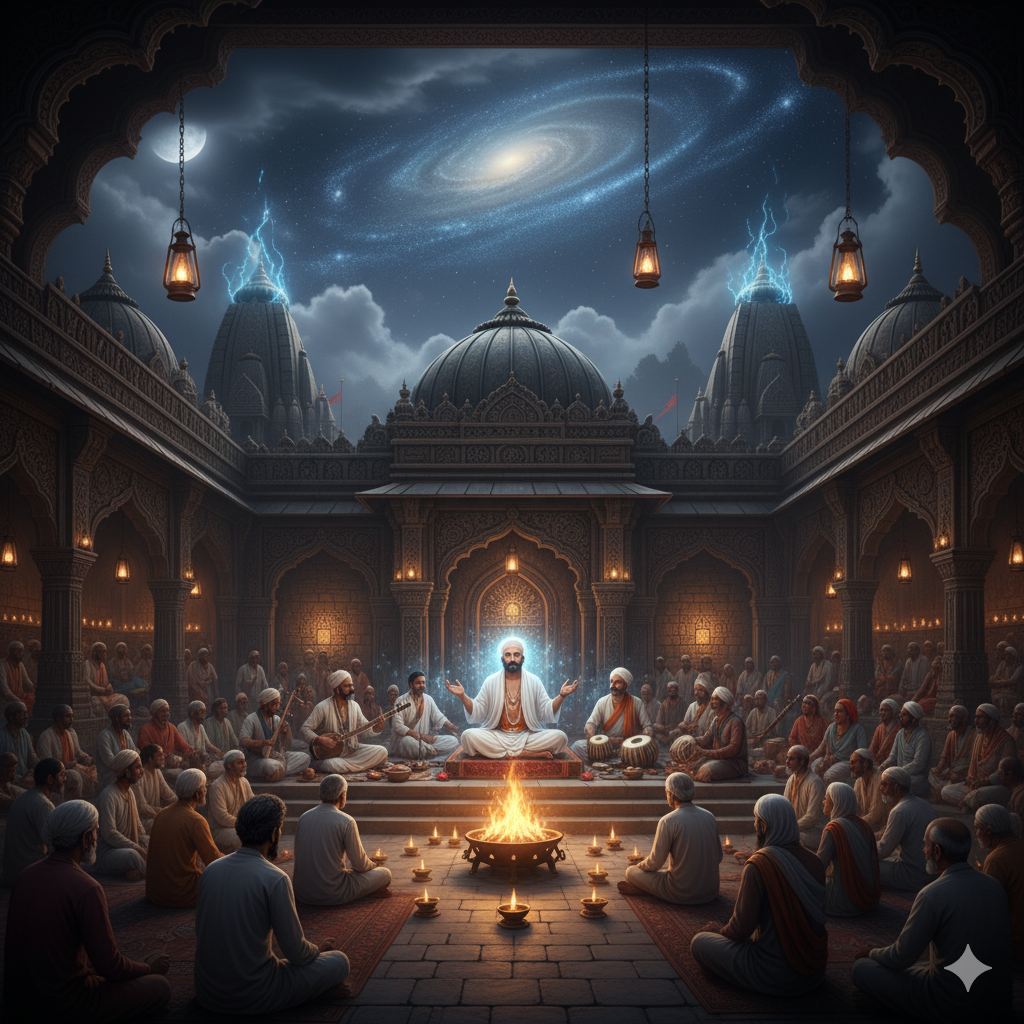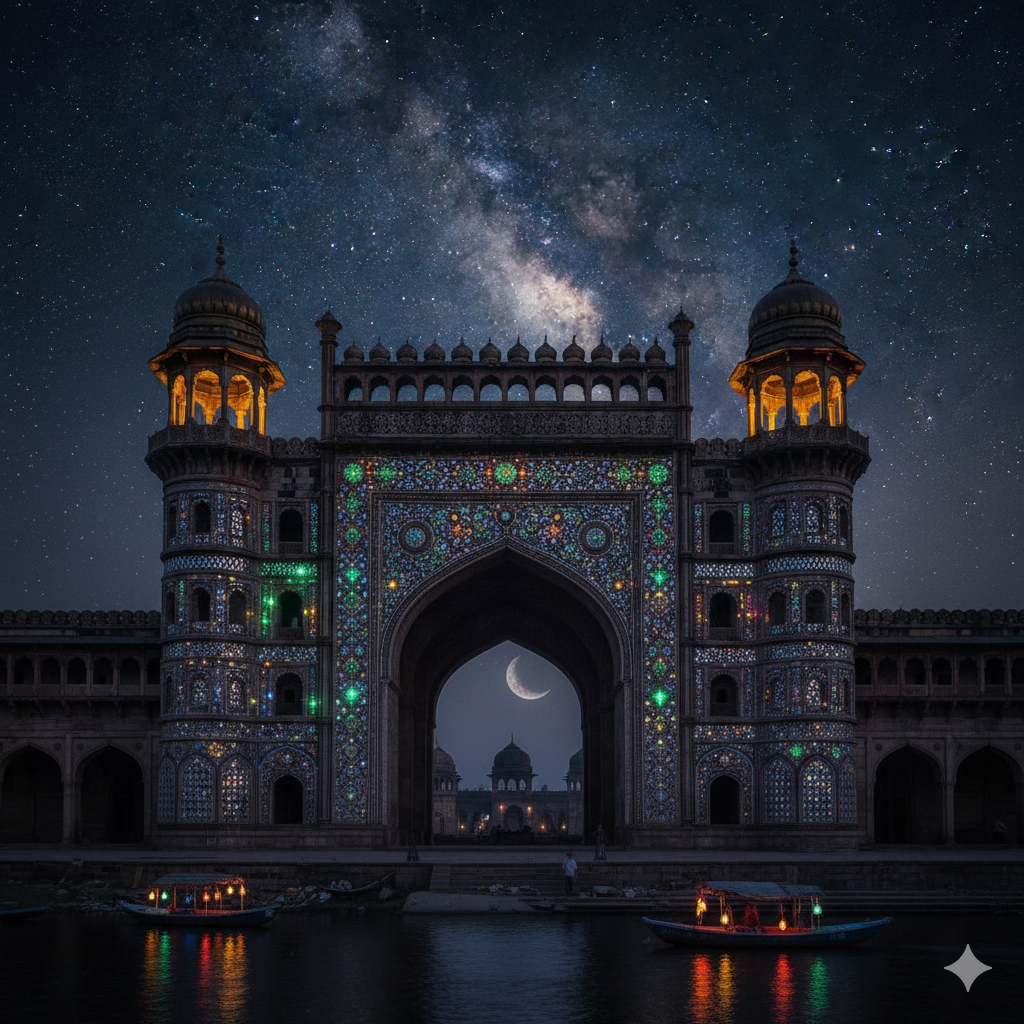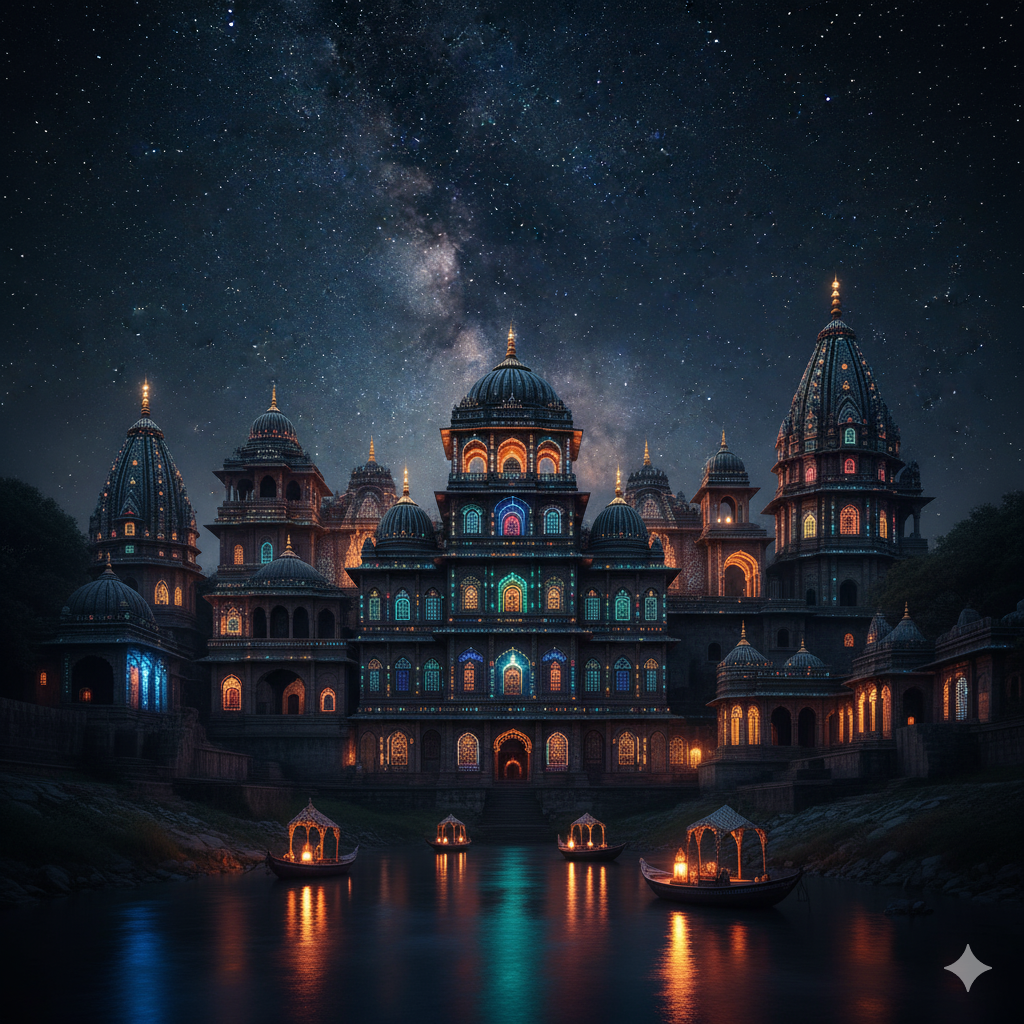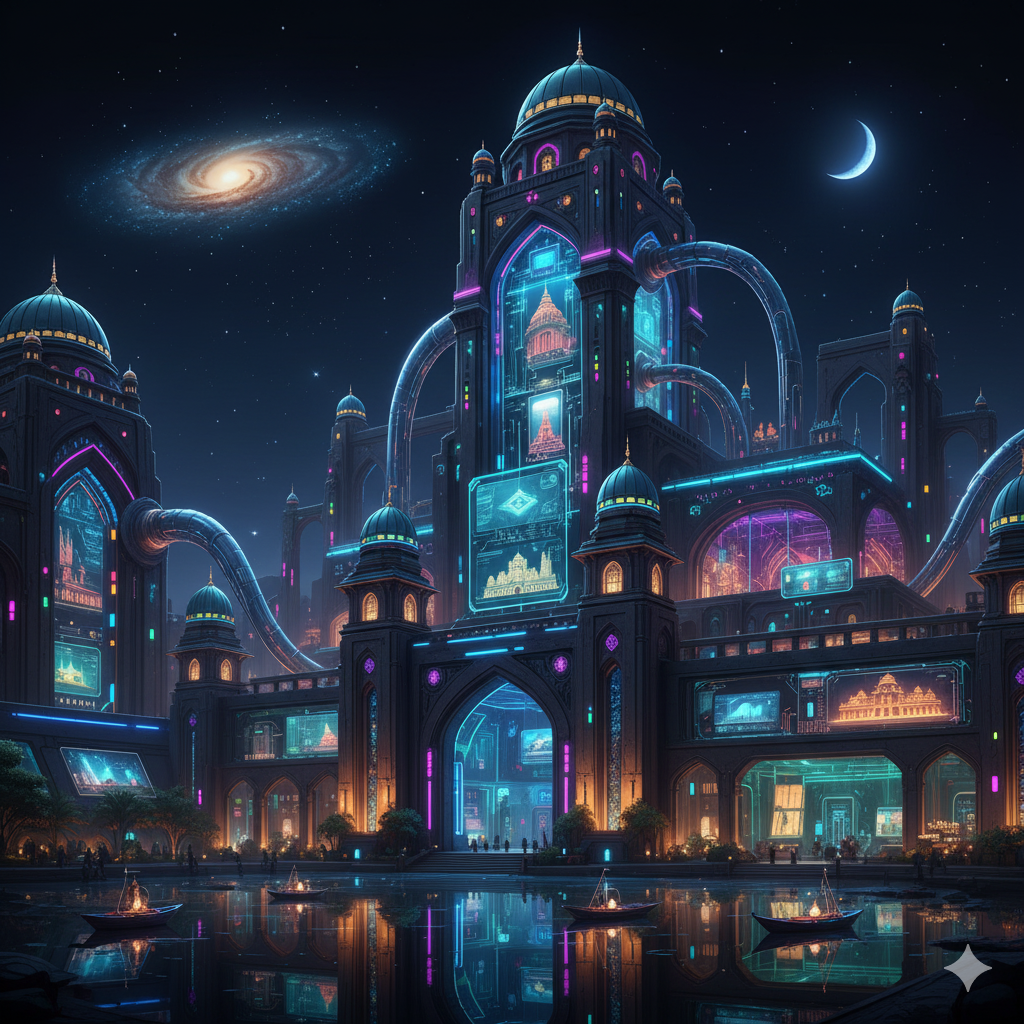Introduction
The Bhakti Movement was one of the most transformative socio-religious movements in Indian history, emerging between the 7th and 17th centuries CE. It played a pivotal role in reshaping India’s spiritual, cultural, and social fabric. The movement emphasized devotion (bhakti) to a personal god as the path to salvation, rather than ritualism, caste hierarchy, or scholastic philosophy.
While the roots of Bhakti can be traced to southern India, its greatest flowering occurred in North India during the medieval period (13th–17th centuries) — a time marked by social unrest, religious conflicts, and political upheaval. Among all northern regions, Uttar Pradesh (anciently known as the land of Kosala, Kashi, and Mathura) emerged as the epicenter of the Bhakti renaissance.
The land of Uttar Pradesh nurtured saints, poets, and reformers whose teachings not only redefined religion but also influenced Indian society, literature, and philosophy for centuries. From Ramananda in Varanasi to Kabir in Kashi, Tulsidas in Ayodhya, and Surdas in Braj, the region became the heartland of devotional revival and spiritual awakening.
Historical Background of the Bhakti Movement
The Bhakti movement arose as a spiritual and social response to the rigidities and inequalities of medieval Indian society. By the 13th century, the Brahmanical orthodoxy, complex rituals, and caste discrimination had alienated the masses from spiritual life. Simultaneously, the influence of Islam and the establishment of Delhi Sultanate introduced new religious and cultural dynamics.
Amidst this environment, saint-poets across India began to preach a message of universal love, devotion, and equality before God. The movement rejected the dominance of priestly intermediaries and upheld the idea that salvation could be achieved through sincere devotion (bhakti), irrespective of one’s caste, creed, or gender.
While the southern saints like Alvars and Nayanars pioneered the Bhakti tradition, the northern phase — particularly in Uttar Pradesh — gave the movement its literary richness, philosophical depth, and social inclusivity.
Uttar Pradesh: The Cradle of North Indian Bhakti
Uttar Pradesh was not just a geographical center but also the spiritual nucleus of medieval Bhakti. Several historical and cultural factors contributed to this:
- Ancient Religious Heritage:
The region was already sanctified by ancient Hindu traditions. Cities like Varanasi, Ayodhya, Mathura, Vrindavan, and Prayagraj were major centers of Vaishnavism, Shaivism, and other spiritual schools. - Cultural Syncretism:
The coming of Islamic rulers introduced Persian and Sufi ideas, which interacted with indigenous spiritual practices. This led to a fusion of Bhakti and Sufi mysticism, giving the movement a broader, more inclusive form. - Language and Literature:
Uttar Pradesh was the birthplace of Hindi and Braj literary traditions. The Bhakti saints composed their devotional verses in the vernacular languages of the masses, thus democratizing religion and literature.
Major Bhakti Saints of Uttar Pradesh
The contribution of Uttar Pradesh to the Bhakti Movement is best understood through the lives and teachings of its great saint-poets and reformers. Their spiritual expressions transcended sectarian barriers and united people through love and devotion.
1. Ramananda (14th–15th Century) – The Pioneer of North Indian Bhakti
Ramananda, a disciple of the South Indian philosopher Ramanuja, is often regarded as the first great Bhakti saint of North India. He settled in Varanasi, which became a vibrant center of devotional learning under his guidance.
- Teachings: Ramananda emphasized devotion to Rama and Sita as the supreme deities. He taught that God could be reached through love, surrender, and remembrance, not through caste or ritual.
- Social Impact: He accepted disciples from all castes and religions, thereby breaking the barriers of social discrimination. His followers included Kabir (a weaver), Ravidas (a cobbler), Sena (a barber), and Pipa (a Rajput king).
- Legacy: Ramananda’s liberal and inclusive teachings laid the foundation of Vaishnava Bhakti in North India, shaping the spiritual climate of Uttar Pradesh for centuries.
2. Kabir (1440–1518 CE) – The Voice of Religious Harmony
One of the most powerful reformers of the Bhakti age, Kabir was born in Varanasi and is revered by both Hindus and Muslims. His philosophy represents the fusion of Bhakti and Sufi mysticism, blending devotion with a deep critique of organized religion.
- Teachings: Kabir preached monotheism and emphasized the presence of one Supreme God beyond rituals, idols, and sectarian boundaries. His verses denounced the hypocrisy of both Hindu and Muslim priests.
- Language and Literature: His poems, known as ‘Kabir ke Dohe’, were composed in simple Hindi, full of metaphors and spiritual insight.
- Social Message: Kabir promoted equality, humility, and universal brotherhood. He rejected caste distinctions and affirmed that God resides within every being.
- Influence: The Kabirpanthi sect, which follows his teachings, spread across northern India, making him one of the most influential saints of medieval Uttar Pradesh.
3. Ravidas (Raidas) – The Saint of Equality
Ravidas, a contemporary of Kabir and a disciple of Ramananda, hailed from Varanasi. Belonging to a community of cobblers, he became a symbol of the Bhakti Movement’s egalitarian spirit.
- Teachings: Ravidas emphasized spiritual purity over birth-based caste identity. He envisioned an ideal society called ‘Begumpura’, where there would be no discrimination or suffering.
- Philosophy: He taught that love and devotion were the true means of attaining union with God. His message appealed to the lower castes and marginalized sections.
- Legacy: Ravidas is worshipped across North India, especially among Dalit communities. His teachings inspired later Bhakti reformers, including Guru Nanak.
4. Surdas (1478–1583 CE) – The Poet of Divine Love
Surdas, born in Runkta near Agra (in Braj region), was one of the greatest poets of the Bhakti era. A follower of the Vallabhacharya school of Vaishnavism, he devoted his life to singing the leelas (divine acts) of Lord Krishna.
- Literary Contribution: His magnum opus, the ‘Sursagar’, contains thousands of verses glorifying Krishna’s childhood and divine play. His compositions reflect bhakti blended with aesthetic beauty and emotional intensity.
- Language: Surdas composed his works in Braj Bhasha, contributing significantly to the development of Hindi literature.
- Cultural Influence: His devotional songs continue to inspire classical Indian music, especially bhajans and kirtans dedicated to Krishna.
5. Tulsidas (1532–1623 CE) – The Saint-Poet of Ayodhya
Tulsidas, born in Rajapur (Chitrakoot, Uttar Pradesh), is one of the most revered figures of Indian spirituality. His monumental work, the ‘Ramcharitmanas’, retells the story of Lord Rama in Awadhi, making the Ramayana accessible to the common people.
- Teachings: Tulsidas emphasized devotion (bhakti) to Rama, moral duty (dharma), and righteous living.
- Literary Works: Besides Ramcharitmanas, he wrote Vinay Patrika, Hanuman Chalisa, and Kavitavali, among others.
- Social and Religious Impact: By presenting Rama as the embodiment of virtue and justice, Tulsidas redefined the moral ideals of Hindu society. His work became a cornerstone of North Indian Vaishnava Bhakti and deeply influenced Indian culture and ethics.
6. Mirabai (1498–1547 CE)
Although originally from Rajasthan, Mirabai’s devotional influence extended to the regions of Uttar Pradesh, especially Vrindavan and Mathura, where she spent much of her later life. Her songs, expressing passionate devotion to Krishna, enriched the Bhakti culture of Uttar Pradesh.
Forms of Bhakti in Uttar Pradesh
The Bhakti Movement in Uttar Pradesh manifested through two major forms — Saguna Bhakti and Nirguna Bhakti.
- Saguna Bhakti (Devotion to God with Attributes):
- Promoted worship of personal deities like Rama and Krishna.
- Saints like Tulsidas and Surdas represented this stream.
- Temples, poetry, and music were used as means of devotion.
- Nirguna Bhakti (Devotion to the Formless God):
- Focused on the formless, all-pervading divine essence.
- Propagated by Kabir, Ravidas, and Nanak.
- Denounced idol worship and sectarian differences.
Both forms coexisted and complemented each other, enriching the spiritual life of Uttar Pradesh.
Social and Cultural Impact of the Bhakti Movement in Uttar Pradesh
1. Promotion of Social Equality
The Bhakti saints challenged the caste system and emphasized the oneness of all human beings. They welcomed followers from all communities — Hindu, Muslim, high caste, or low caste — thus creating a sense of social unity.
2. Religious Tolerance and Harmony
The teachings of Kabir and his followers encouraged Hindu-Muslim unity, reducing religious tensions. The synthesis of Bhakti and Sufi ideals became the foundation of India’s composite culture (Ganga-Jamuni Tehzeeb), which is especially evident in Uttar Pradesh.
3. Development of Vernacular Literature
Bhakti saints composed in Awadhi, Braj, and Bhojpuri, making spirituality accessible to common people. Their works enriched Hindi literature and laid the foundation for Bhakti poetry, which later influenced Mughal and colonial-era writers.
4. Cultural Flourishing
The Bhakti Movement inspired new forms of music, dance, and visual arts. The devotional songs (bhajans) of Tulsidas, Surdas, and Mira became integral to North Indian classical traditions.
5. Ethical and Moral Reform
The movement encouraged values like truth, humility, compassion, and devotion, promoting a moral awakening in medieval society. It brought religion closer to human emotion and away from rigid ritualism.
Bhakti and Sufism: The Uttar Pradesh Connection
Uttar Pradesh was also a prominent center of Sufism, with great saints like Khwaja Nizamuddin Auliya (Delhi), Sheikh Salim Chishti (Fatehpur Sikri), and Shaikh Raji (Varanasi) influencing the spiritual environment.
The interaction between Sufis and Bhakti saints led to shared values — love, tolerance, and devotion — blurring religious boundaries. Many Bhakti poets adopted Sufi metaphors like the beloved and union with God, creating a syncretic devotional culture that defined Uttar Pradesh’s medieval identity.
Legacy of the Bhakti Movement in Uttar Pradesh
The Bhakti Movement permanently transformed Uttar Pradesh’s cultural and religious landscape.
- It laid the foundation for Hindi literature, which continues to dominate North Indian literary tradition.
- It fostered religious pluralism, evident in the region’s tolerant ethos.
- The teachings of Bhakti saints still inspire millions and have influenced modern reformers like Mahatma Gandhi and Swami Vivekananda.
- The devotional music, festivals, and temple traditions in Ayodhya, Mathura, and Varanasi are living continuations of the Bhakti legacy.
Conclusion
The Bhakti Movement in Uttar Pradesh was not merely a religious phenomenon but a comprehensive social and cultural revolution. It challenged orthodoxy, bridged communities, and democratized spirituality. By preaching in the language of the people and emphasizing love and devotion over ritual, the Bhakti saints of Uttar Pradesh united hearts across religious and social divides.
From Kabir’s universalism to Tulsidas’s devotion, from Surdas’s lyrical beauty to Ravidas’s social idealism, the movement gave Indian civilization some of its most profound spiritual and literary treasures. Uttar Pradesh, as the cradle of this transformation, continues to symbolize the timeless ideals of faith, tolerance, and human unity — the very essence of Bhakti.




